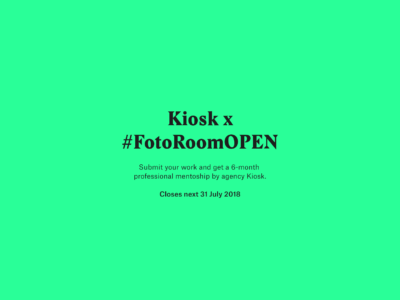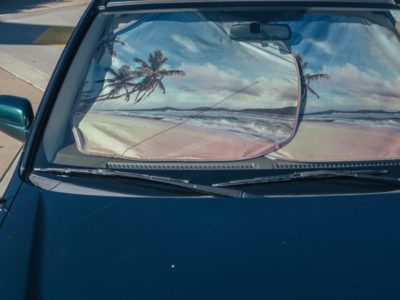Introducing Rubber Factory, the Gallery Where #FotoRoomOPEN’s Winner Will Exhibit Their Work
As the deadline of our current #FotoRoomOPEN call approaches (submissions close next 15 November), we’ve had a short chat with Mike Tan, the founder and directory of that Rubber Factory gallery in New York where the winner of the call may have his work exhibited in a solo show. Read on to find out more about Rubber Factory and submit today to take your chance of exhibiting your work there.
Hello Mike, thank you so much for creating the fantastic opportunity for the winner of #FotoRoomOPEN to have a show at Rubber Factory. Please introduce us to your gallery.
Thank you! We’re excited to see the submissions. Rubber Factory is in the Lower East Side of New York City and we specialize in photo-based works. We’ve been operational for more than a year now and we have a poster division in addition to our gallery space. We work with a lot of emerging artists and try to provide an open-ended space where artists can experiment and take risks with their practices.
When and why did you found Rubber Factory, and what is your background in photography?
I opened Rubber Factory in June 2016, so it has been a little more than a year since we opened. In New York’s contemporary photography scene there’s so much talent and desire to have a public dialogue that it was an easy decision to start the gallery once all the pieces came together.
My personal background in photography is a bit long-winded. I went to the NYU Gallatin School of Individualized Study, which led to a specialized degree called “The Intersection of Fact and Fiction in Photography”. This reflected my interest in philosophy and history, in particular with photography becoming a conduit for these explorations. Then I’ve worked at Yossi Milo gallery and for the artist Hank Willis Thomas. These experiences were very important for my personal vision of what photography and art can bring to the table. Yossi has an amazing eye and cares so much about the details; Hank isn’t simply an artist, he is also an activist, a teacher, etc. They both set the bar very high for me I think.
How would you describe your gallery’s mission? What contribution are you trying to give to contemporary photography through Rubber Factory’s exhibitions?
Rubber Factory’s mission is centered around the desire to return the gallery model to a less commercial format. We think of Research and Development as the key tenets of what we do—this means keeping tabs on as many artists as possible and developing long-term relationships with emerging talent that we feel is aligned with our curatorial vision. I think this is the value-add of a gallery. We can identify talent at an early stage and grow with the artists by giving them a platform to engage with the public.
Another key part of our mission involves diversifying not just the range of approaches within photography, but also thinking about the subject matters we’re shining a light on and the roster of artists we work with as well. The art world, and by proxy the photo world, is still heavily dominated by white males, and this issue is so ingrained that we sometimes don’t even notice it. So we keep a close eye on whether we are working with enough women artists and if we have an international presence within our program.
In many respects, our curatorial focus is expanding the vernacular of the photograph. When I spoke to Stephen Mayes, who used to run the photo agency VII, this idea kept emerging: that the photograph is so ubiquitous and the public is so well versed with the language of the image that there are unique opportunities for the artists to break the boundaries of the medium. This is pretty exciting when you consider how far we’ve come in the last few decades. It wasn’t so long ago that only black and white photography was considered art. All remaining rules in the game are soon going to be redundant (if they aren’t already). We want to be part of this image revolution.
So far, Rubber Factory has mainly focused on artists whose work relies on a strong conceptual basis. Are you hoping to look at more such work through #FotoRoomOPEN or are you keen to consider photographers using different approaches?
It’s true that we like artists who work conceptually but I find that the first criteria for us is always whether the work has a visceral impact. By this I mean something close to what Barthes was referring to with his “punctum”: while it is abstract and multi-dimensional, I subscribe to this idea that we have to be personally affected by the work first and foremost. It just so happens that we live in an extremely fluid era where photography, art and the world at large are experiencing tectonic shifts. In these rapidly evolving times, I find photographs which are alien to me, which have layers of subtextual ideas, to be the most exciting.
Besides the gallery, Rubber Factory is also a cycle of talks called The Assembly and a publisher of affordable photo posters. Can you talk a bit about these two extensions of Rubber Factory?
Sure! We do The Assembly artist talks and publish the posters as a way to democratize the white cube gallery space. I like to think that we do all this for the artists we work with, the community we’re a part of and the public who has an increasing interest in art as a creator of meaning. By having unpretentious events where artists can share work in progress, the idea is to create a casual safe space to learn about the work. The posters take this to the next level by then encouraging the public to live with artworks from artists we think are making great work. Not everyone can afford to buy work off a gallery wall, but $30 for a poster makes it much more likely that there’s something everyone who visits us can buy.
Despite its short-spanned life, Rubber Factory has already participated in top photography fairs like Photo London and PHOTOFAIRS | Shanghai. What are the main challenges for a young gallery to establish itself on the international scene?
The fairs were great for us in terms of putting Rubber Factory in front of so many eye-balls! I think exposure is the most challenging thing for a gallery at this early stage. There are so many images out there, so many galleries with a long history too; so for us to establish ourselves, we really need to bring something new to the table. Finding that niche is the real challenge in a climate where the art market at large is also at a bit of a loss for how to reinvent itself for a new generation. So much of the art market is not transparent and inaccessible in an age where I think we all grew up with incredible open access to information; this disconnect makes art a bit of an outlier I believe. To truly engage with new audiences, not only does a gallery have to be showing challenging new work but also try to pioneer new ways of reaching people in this saturated market.
Finally, what do you see when you think of Rubber Factory’s future?
I see us taking more risks with our exhibitions, growing our community and helping our artists grow. These are our main priorities!
Submissions to #FotoRoomOPEN | Rubber Factory edition will close next 15 November. Enter your work today!
Keep looking...

FotoCal — Photography Awards, Grants and Open Calls Closing in May 2025

FotoCal — Photography Awards, Grants and Open Calls Closing in April 2025

FotoCal — Photography Awards, Grants and Open Calls Closing in March 2025

FotoCal — Photography Awards, Grants and Open Calls Closing in February 2025

FotoCal — Photography Awards, Grants and Open Calls Closing in January 2025

FotoCal — Photography Awards, Grants and Open Calls Closing in December 2024

FotoCal — Photography Awards, Grants and Open Calls Closing in November 2024




